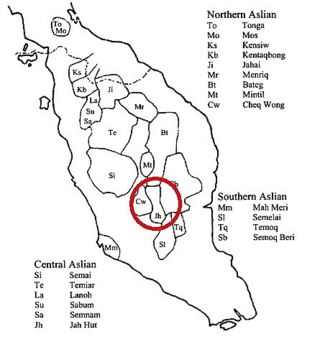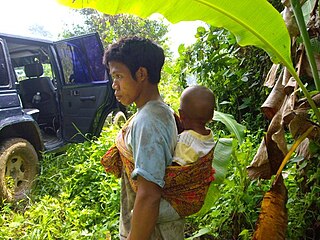
The Aslian languages are the southernmost branch of Austroasiatic languages spoken on the Malay Peninsula. They are the languages of many of the Orang Asli, the aboriginal inhabitants of the peninsula. The total number of native speakers of Aslian languages is about fifty thousand and all are in danger of extinction. Aslian languages recognized by the Malaysian administration include Kensiu, Kintaq, Jahai, Minriq, Batek, Cheq Wong, Lanoh, Temiar, Semai, Jah Hut, Mah Meri, Semaq Beri, Semelai and Temoq.
Semai is a Austroasiatic language of western Malaysia spoken by about 60,438 Semai people. It is one of the few Aslian languages which are not endangered, and even has 2,000 monolingual speakers. It is currently spoken by 3 main groups; the Northern Semai, Central Semai and the Southern Semai.
The Northern Aslian languages are a group of Aslian languages spoken by about 5,000 people in inland areas of Peninsular Malaysia, with a few pockets in southern Thailand. The most distinctive language in the group is the outlier Cheq Wong, which is spoken south of the Central Aslian language Semai. The other languages apart from Tonga can be split into two divisions:
The Senoic languages are a group of Aslian languages spoken by about 33,000 people in the main range of the Malay peninsula. Languages in the group are: Semai and Temiar, Lanoh, Sabüm, and Semnam.
The Southern Aslian languages are a sub-branch of the Aslian branch of the Austroasiatic language family. They have also been referred to as the Semelaic languages, but this label is no longer used. The four languages that make up the branch are:
Semelai is an Austroasiatic language spoken in the Malay Peninsula. It belongs to the Southern branch of the Aslian language subgrouping. The Semelai reside predominantly around the Bera, Serting and associated river systems in the states of Pahang, Negeri Sembilan and Johor.
Jakun is an Austronesian language, perhaps a dialect of Malay, spoken in Malaysia. Specifically it is spoken on the east coast and inland of Peninsular Malaysia, around the Pairang River, from Pekan in Pahang to Sri Gading, east to Benut, northwest to middle Muar River area around the districts of Segamat, Muar and Tangkak in Johor. It is also known as Djakun, Jakoon, Jaku’d, Jakud’n or Orang Hulu.
The Leipzig–Jakarta list of 100 words is used by linguists to test the degree of chronological separation of languages by comparing words that are resistant to borrowing. The Leipzig–Jakarta list became available in 2009.

Jah Hut is an Austroasiatic language spoken around the Krau river in peninsular Malaysia. The Jah Hut are one of the indigenous Orang Asli peoples.
Mah Meri, also known as Besisi, Cellate, Hma’ Btsisi’, Ma’ Betisek, and “Orang Sabat”, is an Austroasiatic language spoken in the Malay Peninsula. Along with Semaq Beri, Semelai and Temoq, Mah Meri belongs to the Southern Aslian branch of the Aslian languages. Mah Meri is the only remaining Aslian language spoken in a coastal area and its speaker population is 3,675 as recorded at the Orang Asli Museum in Gombak. A dictionary of the Mah Meri language has been compiled by Nicole Kruspe.
Temiar is a Central Aslian (Mon–Khmer) language spoken in Western Malaysia by the Temiar people. The Temiar are one of the most numerous Aslian-speaking peoples, numbering around 30,000 in 2017.
Jahai (Jehai) is an aboriginal Mon–Khmer language spoken by the Jahai people living in the montane rainforests of northern Peninsular Malaysia and southernmost Thailand. It is the largest Northern Aslian language. Though spoken by only a little more than 1,000 people, Jahai does not appear to be in immediate danger of extinction due to the prevalence of Jahai parents passing on the language to their children as their mother tongue.
Ten'edn, also known as Mos in Thailand and Tonga-Mos or just Tonga in some literature, is an aboriginal Mon–Khmer language spoken by the Maniq tribe of Thailand and Malaysia.
Batek is an Aslian language of Malaysia, spoken by the Batek people. The Mintil, Dèq and Nong dialects may be separate languages. The number of speakers is small and decreasing.
Kintaq, or Kentaq Bong, is an Austroasiatic language spoken in Malaysia and Thailand. It belongs to the Northern Aslian sub-branch of the Aslian languages. The small number of speakers is decreasing.
Temoq is a severely endangered Austroasiatic language spoken in the state of Pahang in the Malay Peninsula. Temoq belongs to the Southern branch of the Aslian languages, along with Semelai, Semaq Beri, and Mah Meri.
Semaq Beri is an Austroasiatic language spoken in the Malay Peninsula in the states of Pahang and Terengganu. It belongs to the Southern division of the Aslian languages, along with Semelai, Temoq, and Mah Meri. A preliminary description of the Semaq Beri language by Nicole Kruspe was published in 2014.
Semnam is an aboriginal Mon–Khmer language spoken by the Semnam subtribe of the Lanoh people in Peninsular Malaysia.

Cheq Wong people are an indigenous Orang Asli people of the Senoi branch in Peninsular Malaysia. Although they have the physical appearance of the Senoi sub-group, the Cheq Wong language that they speak is closely related to the Northern Aslian languages.
Jedek is an Aslian language from the Austroasiatic family first reported in 2017. Jedek speakers describe themselves as ethnic Menriq or Batek to outsiders, but their language, although very closely related, is distinct from these languages.



